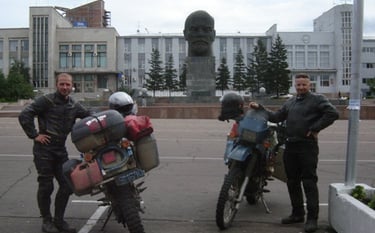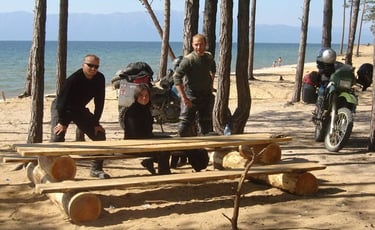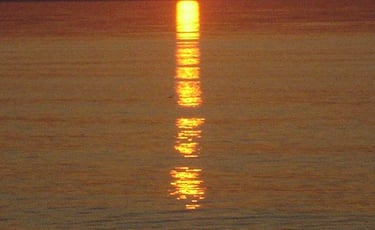2005 AROUD THE WORLD
SIBERIA
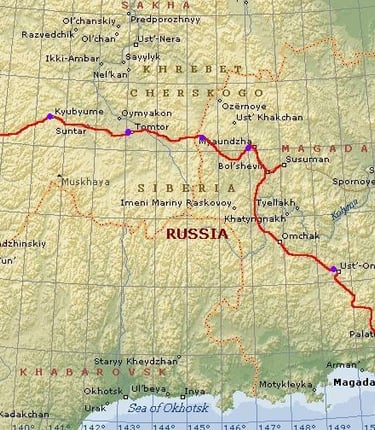

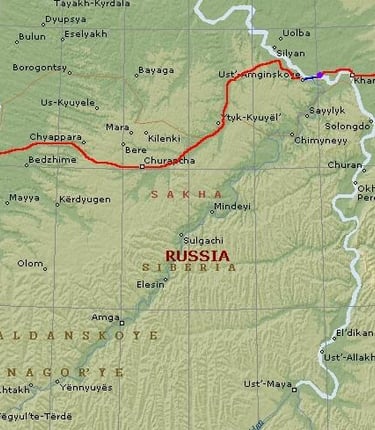

After arrival in Magadan we travelled through eastern Siberia The Road of Bones.
The "road" was very rough. The obstacles included river crossings (most of the bridges were destroyed by high waters that occur in the spring time), 30-40 metre long puddles (sections with no proper foundation), swamps (trying to go around the "puddles"), and very difficult dirt/stone/gravel roads.
Day 26 (for Jacek: Day 1) – July 1, Flight to Magadan and crossing the International Date Line
Around 5am it started to get busy. Mrs. Johnson opened her office and soon the procedure began. We were issued tickets, they weighed our luggage and we were sent off for luggage scan. Here very nervously working gentlemen insisted to see the contents of each box. Darn, I wrapped mine so tightly. One officer had a hell of a time with my cases. He took my key but could not open them. I got them opened for him but I could not touch them. The contents spilled on the examination table, he checked them all right but could not close the case. Poor man, cursed and sweated but did not let me touch the cases.
Finally we boarded the plane, a three engine TU154, owned by Mavial Airlines. It was old but still in decent condition. A very pleasant hostess directed us to our seats but we ended up sitting pretty much anywhere at the back. The plane was half full. The majority of the passengers were American adventure seeking anglers, hunters, and bird and volcano watchers. There were also some gentlemen going to Russia to look for or meet the famous Russian Lady.
The plane taxied through the run way and took off smoothly. It was a really peaceful flight, nothing to be scared off.
Day 27 (2) – July 3, Magadan to Ust-Omchug – 293 km
I called Pyetia as we agreed at around 10am. Soon the guys showed up with their snazzy Toyotas and took us to their garage. I showed Zhenia my broken luggage brace. A new aluminum piece had to be made.
Since it was raining on and off, a typical Magadan weather, the guys offered to drive us around the city: the harbor, Lenin’s statue, main square and the latest monument, the Mask of Sorrows. Erected on the nearby hill the monument is a reminder of the horrific Stalinist times when millions of political prisoners were sent to local gulags and died working in mines and on road construction. It was a moving moment for us since many Polish people died here.
We made a few stops at different hardware stores; yes they were open on Sunday, until we found the right size of aluminum tubing. Back in the garage Zhenia got to work on my luggage frame. With the right tools he was done before I knew it.
We still had half a day left so we decided to leave Magadan today. In our full rain gear, it was raining hard now, we rode to the beginning of the Road of Bones at a centrally located TV tower, took a historical picture, gassed up with a 92 octane leaded gas and reluctantly left the gloomy town. Pyetia and Zhenia escorted us to the outskirts of the city and we said good bye. Thanks guys for helping us with the repairs, sending our spare tires to Novosibirsk and for being such great hosts, you were awesome.
First 50 kilometers we rode on asphalt until we got to Palatka where there was a militia post. The area around Magadan is a duty free zone where imported vehicles can be driven without paying duty on it. Beyond this point the locals have to register their cars to legally drive in Russia. Usually the officer checks who leaves this area but I guess he was not interested in tourists. Earlier Zhenia nad Pyetia suggested we should take another good road with all the bridges to avoid a busy and dusty Kolyma proper. Thus in Palatka we turned left onto a gravel road which would also take as to Susuman.
Indeed it was a decent ride with quite frequent small potholes but nothing to brag about, just shaky. Soon the mountains started, we reached a pass. Quite stunning scenery, very rugged terrain, few trees and bullet holes in the sign indicated the remoteness of the area. It stopped raining and the ride became actually very pleasant.
We stopped by an ice field and curiously admired it. Since we rode first in line we didn’t notice when Jacek and Kris stopped. We waited for a while but it was pretty obvious that something must have happened. We rushed a few kilometers back to find Jacek and Kris disassembling Jacek’s bike. Oh no! The two bolts holding the sub frame, KLR’s week point, broke off leaving the endings inside the threads. With few options left the guys decided to strap the sub frame to the main frame, leave the luggage in the bushes and have Jacek ride his bike standing on foot pegs to the nearest establishment. With the plan almost at its realization I waved a car to stop. It was the first vehicle we saw so far. An off road ready Toyota Land Cruiser stopped slowly. A middle aged man dressed in military/hunting attire came out. We asked him to take Jacek’s luggage and if he knew of any mechanics in Ust-Omchug. He looked at the bike, assessed the damage, smiled and said it was a small problem and that in this region everybody is a mechanic.
Surely we liked his positive attitude and also knew that with the right tools we could fix the problem ourselves. With Jacek standing on foot pegs the convoy slowly proceeded towards the next village. On the way we spotted a working gold dredge. It looked exactly like the one in Alaska. In Ust-Omchug our spontaneous mechanic took us to his relative’s garage. There he prepared a super strength Bosh drill, titanium drill bits made in Russia and a set of easy outs, bolt extractors.
The guys tirelessly worked for a couple of hours taking their turns with the drill until the goal was achieved. Jacek also noticed that he lost a drive chain pensioner, not a big deal. In the mean time we were invited to see some vegetable gardens/ hot houses. It was quite awesome how here, in the middle of nowhere; people try to survive by planting their own gardens. They guy was so proud of his cucumbers, paprika and tomatoes.
Natasha and I took a little tour around the village. It was a complete shock to see the way people lived in this partly abandoned place. Large potholes everywhere, rusty structures, falling a parts buildings and garbage, lots of it were the typical features. Nevertheless, there were well dressed people on the streets. Around midnight, still day light, we said thanks to the “mechanic” (who reluctantly accepted $10 gift for the repair) and headed to look for gas. We had to gas up here since for the next 350kms there would be no gas station.
It was late and the attendant was still there hidden behind steel bars. It was actually a 24 hour service. We stocked up on some “tushonka”(canned meat) and “sala” (pork fat) in the nearby store, open 24 hours too. We set up our camp few kilometers from the town and away from the road. It was actually dark when we went to sleep.

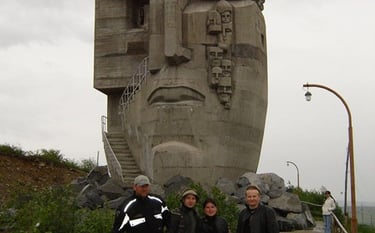

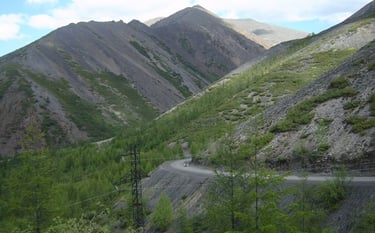
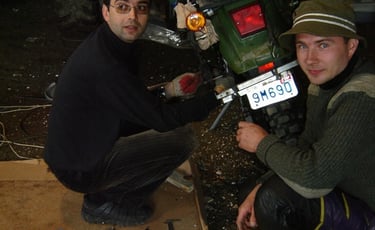


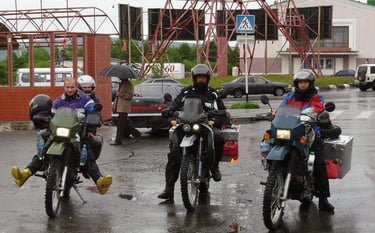

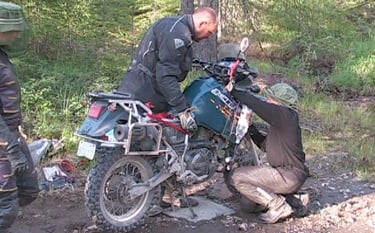
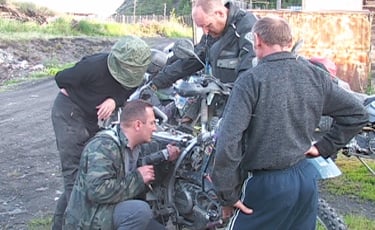

Day 28 (3) – July 4, Ust-Omchug to Arkagala River crossing by Kadykchan– 426 km
We followed the mountain road to Bolshevik crossing some large rivers including Kolyma. Luckily it was an uneventful though interesting ride. We really enjoyed admiring the views and just being alone. We met no vehicles on this stretch.
In Bolshevik we had to take the very dusty Kolyma proper, a federal road, to Susuman going back some 50 kilometers. From here to Tomtor there was nowhere to get gas except in Susuman.
The city boiled in the scorching sun. It was around 35C and very dry. The wind lifted sand and garbage off the wide partly asphalted streets carrying it along blocks of apartment buildings. The place seemed poorly inhabited and only few onlookers showed up. We ate a hardy lunch of warmed up prepared food in a decent eatery with a sink and running freezing cold water. There was really no reason to stay here. We stocked up with provisions, filled up with gas (92 leaded), had a last look at the seemingly crumbling city and hit the dusty road again.
Oh, it was a devious experience trying to overtake a truck. There was no way to do it on a straight stretch as the truck would accelerate leaving even bigger dust cloud behind. Completely blinded I managed to catch up as the Kamaz came to a crawl when climbing a steep hill. This time I passed it without an incident though at 80km/h I blindly hit a section of loose gravel. Jacek stayed behind looking probably for a safe opportunity.
We stopped at the roadside parking to ask for the turn off. The kamaz driver shook his head and told us that the road is very bad and most of the bridges are down. He said that the road to Yakutsk goes through Ust-Nera, it is completed and all the trucks go there now. I didn’t know the real condition of that road but from what he was saying it was a good but very dusty gravel road. Anyway, we were not interested in this route. We wanted to take the picturesque and “leisurely” Old Kolyma.
We took the right turn off, according to my GPS, and followed a decent gravel road for, well, 1 kilometer, when the first obstacle appeared. Kris heroically flew through the 20 meter long pools of water with just a few wobbles and disappeared. He’s done it before, we haven’t. It was our first waterhole to be crossed with full luggage. We approached it methodically. Jacek put his waders on, walked the pool and removed some logs. Success, we both crossed it with only a small wobble. The next one was too deep so we followed the bumpy detour without a fall. In the mean time Natasha walked around and laughed at our misery. My boots were wet and even Jacek’s waders didn’t help.
We caught up with Kris at the first river crossing. The bridge was down and the river was relatively wide though the water was quite low. Kris already found a suitable crossing path and rode his bike across. Now it was time for him to teach us how to do it. For safety we removed our luggage and followed Kris’s directions.
How to cross a river safely: walk it first, find a suitable launch path up stream, ride it slowly down stream and across to a preplanned safe area. Try your best not to kill the engine as it maybe difficult to start it when the air has to be sucked into the submerged motor.
Of course this technique would apply to a fast flowing river of a depth no higher than your bikes air intake. Our first crossing took us some time but, thanks to Kris, it was a positive learning experience. Thanks to Kris for his patience.
With our pants completely wet we set up a camp and made a huge fire. Everyone went to sleep while I stayed up drying my leathers, listening to the water flow and in general being unable to sleep due to the constant day light.
It started as an easy day but it turned into a difficult yet fun activity. I thought how lucky we were having a beautiful weather. Or maybe we were here just at the right time, the first two weeks of July.

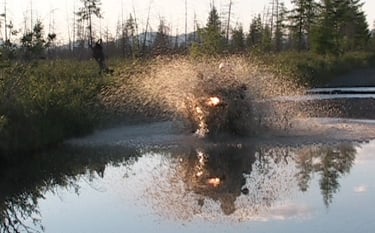
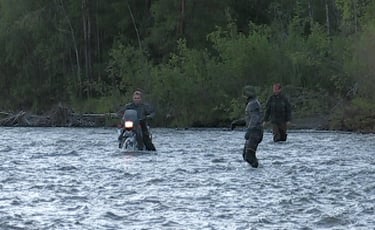

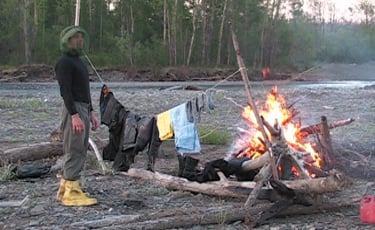

Day 29 (4) – July 5, Arkagala to Ayan-Yuryah River crossing – 108 km
Energized and relatively rested we had a basic breakfast of bread and canned meat.
We knew the most difficult section was before us. With his waist high waders Kris was best prepared. Jacek had his thigh highs and I, least prepared, had to have my rain pants taped to my rain boots, a rather experimental option.
The gravel track started innocently with a small river crossing and an uncertain turn off. GPS came in handy showing us correct direction. Up and down we went through the mountains, riding around regularly distributed big potholes, washed-off sections and some small muddy ruts. We followed the river gradually descending to a lower lying area, “the wet lands”.
At the first pool Kris, our hero, attacked it without walking it. He barely entered it when his front wheel completely disappeared. The bike went down on Kris pulling his body under water. We could see his head, left shoulder and his left leg sticking above to surface. Somehow he grabbed onto the edge of an underwater rut to save himself from drowning. Quickly we jumped off our machines to the rescue. It wasn’t easy but we managed to lift his heavy loaded KTM.
At the next river crossing, to our complete amazement, we met a couple from Switzerland. They bicycled from Magadan to Yakutsk. I hope they arrived to their destination safely. My experimental waders didn’t work and I sweated in them too much so I decided to continue with the military style (wet pants, leather boots). I was wet up to my thighs for the whole day.
We continued through 40 meter long waterholes and when it was possible we road around them. At several points there was more water than road so we stopped on small islands to walk yet another pool. It seemed that Jacek’s bike didn’t want to cooperate when riding through deep water so we had to pull him out a couple of times. I also put the bike down in water when trying to cross a pool with Natasha. At one large pool, I managed to ride thorough it somehow, Kris and Jacek decided to ride around it. Kris somehow managed to ride through the swamp, after getting stuck once. Jacek, however, with his heavy luggage was less fortunate.
His KLR was virtually sucked by Siberian swamp. Three guys and we couldn’t pull it out. Finally, after Jacek took his entire luggage off, with lots of pulling we put the bike on its side and dragged it out. The entire day Natasha walked more than rode with me. She took pictures, taped our struggles and in general laughed at our misery.
We set up a camp around 9pm with mosquitoes in their frenzy. Actually, with the right protection (mosquito nets and spray) I don’t really remember them bothering me too much.
Kris wanted to continue but we talked him into staying with us one more night. It was a sorry site when I unpacked on of the panniers. There was some water in it and our video tapes were all wet and full of murky water.
I prepared some noodles on my camping stove. Everyone appreciated few slurps of a hot meal.


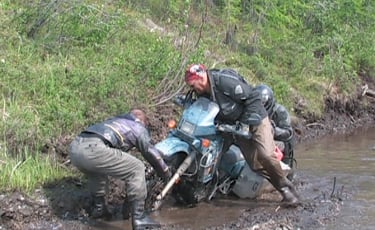

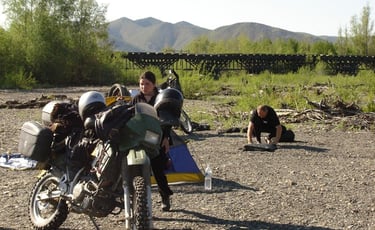

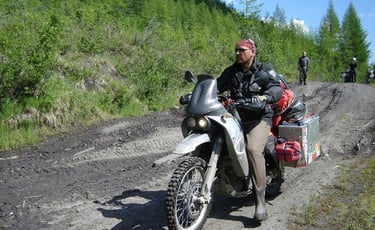



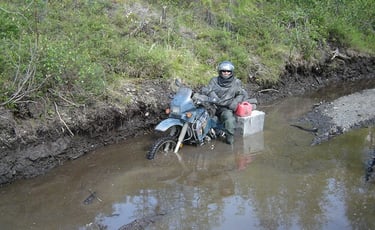

Day 30 (5) – July 6, Ayan- Yuryah to Tomtor, Yakutia – 150 km
We said good bye to Kris and he sped away. Knowing his off road abilities and his physical strength he could ride much faster thus covering bigger distance. He hurried to see his family vacationing in Poland.
It seemed like the swamps ended. A new mountainous area appeared on the horizon. Today’s feature was crossing numerous creeks and small rivers. Often I could ride through them with Natasha on the bike. At one creek the boulders were the size of giant soccer balls or bigger, we had to move the bikes slowly across the water.
At the border of Yakutia the road dramatically improved, with more bridges and only few waterholes.
It was so hot we decided to relax and wash up a bit. Jacek actually took a dip in freezing water; I think he has an elephant skin. To wash Natasha’s hair we used our camp shower. Cold creek water warmed up to a decent temperature in less than an hour.
About water: you can drink it as long as it comes from small creeks and it looks clear. Since it was very hot we drank quite a lot of it and nothing happened.
As we approached Tomtor we looked back at the sky and thought how lucky we were. Behind us there was a huge rain cloud. I don’t wish anybody going back there during rain.
The river Indigirka was a very wild site. Washed down trees and despite low level the water was still everywhere. We crossed the barely standing bridge with caution.
Soon we met two locals, first people in two days, working on their Uaz. The battery was dead so we helped them push the car uphill. it was already late when we arrived to Tomtor, apparently the coldest inhabited place on earth, -83C. Others say it is Oymiakon situated a bit further north.
Since all the stores were already closed we gassed up with a 93 leaded gas and out of curiosity took a tour around the establishment. We cruised the wide earth streets slaloming around huge potholes and in a way admiring the way of living. Yakutians live in mostly wooden cottages with their limited livestock and other belongings within their compound. They often don’t speak Russian or if they do they don’t want to speak it. They are regarded by Russians as low life alcoholics and are feared off.
With still a warm night, around 20C, we found a secluded place outside the village.
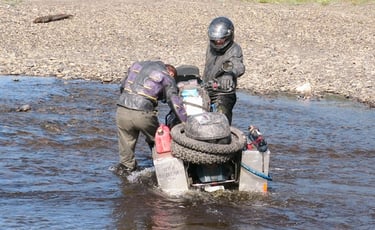



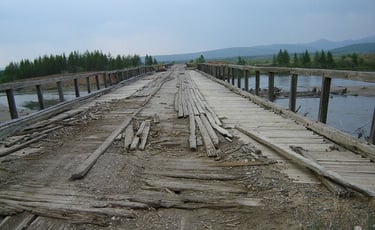

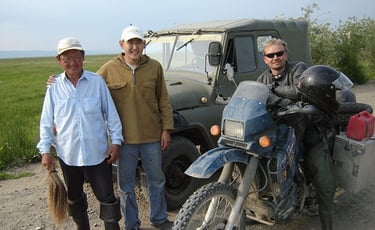

Day 31 (6) – July 7, Tomtor to Kyubyume River crossing – 161
Life was slowly waking up in Tomtor. Now, with brighter light we could better see the village and its inhabitants. Mostly Yakutian people started coming out of their cottages for a morning of shopping. The stores were spontaneously distributed “downtown” and carried everything from groceries, vodka, clothing, footwear to motor oil and car/motorcycle parts. In all it was a well supplied place. We stocked up with more groceries (pork fat, canned meat, vodka, water, bread), had a hardy breakfast and enjoyed the company of curious locals. The people with Uaz (from the day before) showed up and greeted us nicely. The young guy actually spoke pretty good English. A Ukrainian in a T-shirt stroke a conversation asking us the usual question: Where are you from? Where do you come from? Where are you heading? What is the bike? How many CC? How many horse power? (in Russian it is: how many mares) How many liters of gas in the tank? What’s the consumption? How much is the bike?
Since he was so curious, we also became curious and asked him about his whereabouts. He said he came here to work, found his wife and never returned to Ukraine. He also explained how to cross the biggest obstacle on our way to Yakutsk, the river Kyubyume.
We started with a decent weather but soon we were forced to put our rain gear on. It didn’t rain all the time but with the drop of temperature it was better to keep dry at all times. We observed quite beautiful scenery with some lakes, small mountains and large ice fields.
Uneventfully we arrived to Kyubyume and stopped at the gas station. The place seemed really abandoned and we almost lost faith in getting some petrol today. Was it a person walking towards us? I guess it was. From far away we could see an older woman and her dog slowly approaching us. Hurray! It was the gas woman. This time we took what was available, the worst kind, a 76 leaded. We asked for the approach to the river crossing but the woman just told us to follow the tire tracks. It was actually the wrong way and we made a circle around the fallen bridge.
A small 4x4 Uaz van struggled to drive along the ice field on the river bank but easily made it through the deepest crossing. Now we knew the right way to go. We could even see Kris’s tire tracks. He must have crossed it the day before.
A big dark cloud was approaching from the south-east. If the water level raised ½ a foot we would have to look for a truck to take us across. It was now or who knew when.
Jacek walked the thigh high freezing water first and carried his boxes across. We decided not to ride the bikes but rather slowly walk them across. The current was too strong and the bottom was too loose. First we escorted my bike. It wouldn’t be that hard if it wasn’t for the fast flowing water. At one point the bike lost ground and floated a few feet downstream. We managed to hold on to it and without damage my KLR was on a long island. Escorting Jacek’s bike was a breeze. By now I couldn’t feel my legs. Next step, we had to ride across an ice field. If you’ve never ridden on ice or snow I don’t recommend it. It is way worse than in sand. We both fell in the process and ended up pushing the bikes. The longest crossing was a 200 meter shallow which Jacek attempted to ride. Bouncing on big rocks like riding a stallion he fell with 30 meters to go. It looked scary but luckily nothing happened to him or the bike. Some locals appeared, jumped out of a truck and helped him right the bike. Fully loaded and with the engine on the first gear we walked my bike across. Actually, the heaviest job was to carry Natasha across. It is not easy to negotiate underwater obstacles with 55kgs on the back.
Essentially that was it. We rode the Road of Bones without an incident. The rest of the road to Yakutsk was supposed to be dry. We camped on the higher grounds of the river bed at N63 25.838, the furthest point north we traveled in Siberia.
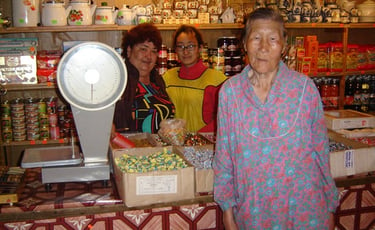



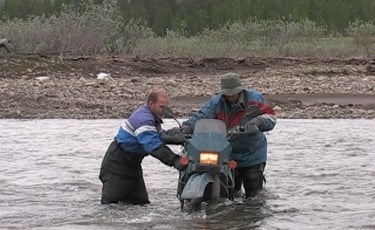




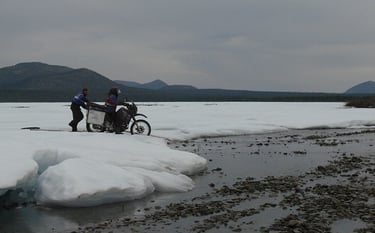
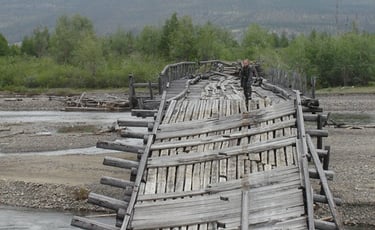

Day 32 (7) – July 8, Kyubyume to Kyeskil on Aldan River – 361 km
Today we constantly drove along different rivers. One more creek crossing, I think the last one in Siberia. I attempted to do it with Natasha and, no luck this time, the bike wobbled, came to a stop and I had to put it down in the water. It wasn’t a big deal just our feet got wet again.
A mountain range appeared and the next couple of hours we maneuvered between fallen rocks on a pretty rough twisty track very often on first gear. The last stretch to Khandyga was a corrugated gravel road. Comparing to previous roads this one actually had a considerable traffic. Here we were completely shocked to see a walking woman who pulled a two wheel cart. Later we found out that it was Rosie, an English woman on her run around the world. You can check her progress here http://www.rosiearoundtheworld.co.uk/
Asphalt in Khandyga was a blessing, finally my hands stopped shaking. It is a city with apartment buildings, some industry and a river port. Most of it is in a sorry state of disrepair.
In the heat of the day, over 30C, we stopped by a nearby “stalova” (eatery) to have some cooked meal. It was actually a disco by night and the sparkling ball was on. We had some meat, lots of salad and some potatoes. It was a great relieve.
Outside the wave of onlookers kept changing but one group of boys stuck around so I paid them to watch the bikes. I asked them why they came here. The answer was simple: to make money. People come here for the higher wages, make enough money and go back to where they came from. It is a constantly changing population.
After gassing up with some 86 octane fuel we left the city to experience the local “civilized” road. For the next 40 or so kilometers we had to ride through deep ruts of sinking golf ball size stones. Maybe it was a decent surface for heavy trucks; it wasn’t fun for us though.
In Kyeskil we asked some locals for today’s location of the ferry. It changes every day.
At the end it was just a dirt track on the bank of the river but we found three rusty vessels at the end. Aldan is considered a big mountain river. It was enormous with slow flowing brownish yet very clean water. Interestingly, near the ferry docking there was spontaneously designated area for waiting passengers with a patch of land for parking or camping, an outhouse and a sign “don’t litter”. Before we managed to set up our camp a drunken Russian man profoundly insisted to share with us his best Yakutian vodka. Thanks to the other, sober, travelers who managed to talk him into leaving us alone.


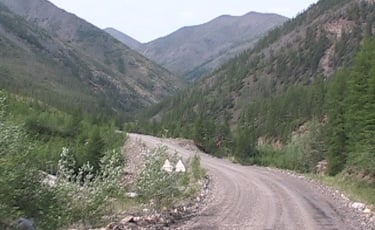

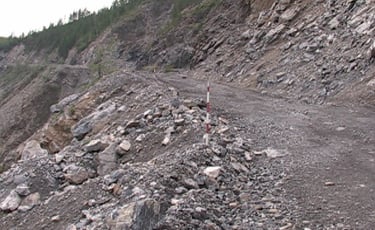

Day 33 (8) – July 9, Kyeskil to Yakutsk – 369 km
Hurry up, said Jacek. The barge was supposed to leave soon. For now there are barges taking vehicles across. The Yakutian operator told us that there are plans to build a bridge over the Aldan River and his summer job may end one day. In the winter the traffic moves over the ice and only in the spring and in the fall, when the ice is too thin the traffic is halted.
The ferry slid onto the sandy shore, lowered its ramp and let us go. It was a newly used area since the road was only opened this year. Before that, cars had to be ferried further downstream to Bulun. The idea of the new road sounded positive. However, in Russian understanding a new road is when the trees had been cut through the swamp and a rough earth foundation had been laid. The section started with golf balls and soon turned into small loose pebbles. I tried to stay upright for a little while but riding two up wasn’t much realistic. The front wheel dug into the road and I had to put the bike down while Natasha made a controlled soccer ball style fall on the soft surface. In the mean time I saw Jacek pressing forward like a Russian tank.
Going alone wasn’t a big deal. Our luggage was minimal and the KLR, though dancing like a ballerina, managed well. I passed some huge bulldozers and a construction crew camp when the sand started. It was deep but more stable. I stopped. Far in the distance I could see Natasha slowly walking towards me.
We made it through the sand and even through the newly erected earth mound. Deep ruts and soft sinking earth, I couldn’t imagine anybody trying to ride this in the rain.
Midday it was hot, around 35C. Soon we left the swamps and entered a completely different area. More villages, farm land and green pastures accompanied us all the way to Yakutsk. The road was good; we could do comfortably 80km/h. except the last 100kms where it changed to foot deep washboard and golf balls. It was a good test for my “Progressive” suspension.
Today was for sure a ferry day. At the ramp Jacek had to answer all the usual questions before boarding. This time the ferry ride was much longer. Lena is a humongous river. We couldn’t really say the land we saw on the horizon was just another island or the western shore.
On the western shore we were approached by a German couple who traveled from Europe to Magadan in their well equipped 4x4 pick up truck (air intake above the roof). They were accompanied by a local news reporter who politely asked for an interview but since we were not interested he just took some pictures. We quickly shared our experiences and parted wishing each other luck.
Yakutsk is a city on stilts. Permafrost starts here a few meters below the ground and all buildings here should be erected on stilts dug deep into the frozen earth. Heating pipes form a maze of their own as they too have to be above ground. It is not a pretty site. The most interesting are the streets. In the short hot summer the surface earth defrosts making the road sink resulting in huge splits in asphalt. Riding in Yakutsk is like going through a recently bombarded city.
We headed for downtown. Here a friendly fellow offered to follow him to a motel. We slalomed behind him to a rather questionable place. It was decent but the old wooden apartment building had no hot water. Friendly fellow took us back downtown to a “stoyanka” (fenced parking) where he received a pack of Marlboro. With little knowledge about the city Jacek went to the nearby expensive hotels to inquire about accommodation. Natasha and I just waited there when a curious man approached us. The usual questions were followed by a friendly conversation. We asked if he knew someone who could weld Jacek’s luggage frame. He gave us his cell number and said he would do it tomorrow. He gave us some yogurt and offered some food. When Jacek returned he shocked us with the hotel prices. Hearing this Andrey surprised us with his offer. He would let us stay in his small second flat, situated near his workplace. He said it wasn’t anything fancy but there was hot water. It was just great. We mutually accepted the offer without hesitation. I thought sometimes it pays to just wait.
There was no electricity in the flat that night but who needed it. We just wanted to wash up in hot water. I really could not believe when Andrey offered to drive me to get some products. We wanted some dried fish to have with beer so he drove his Lada from store to store to find it. His hospitality was beyond our expectations, I was stunned. Andrey left us around midnight.


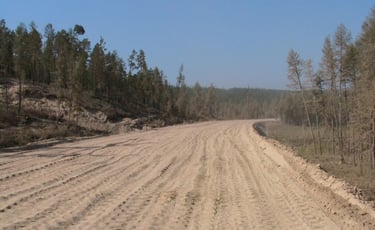

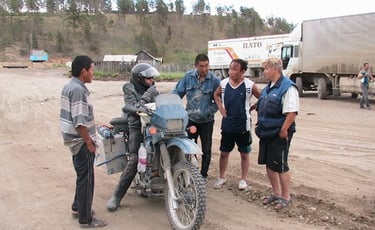

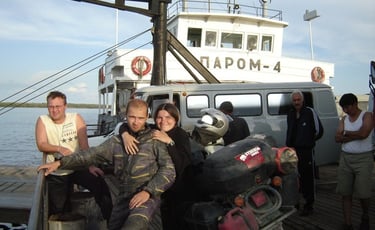


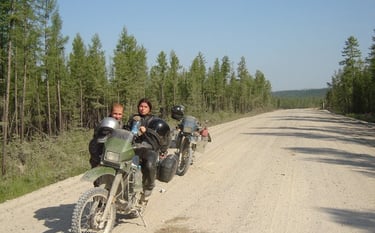
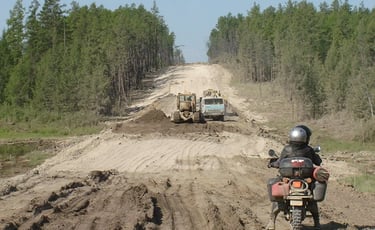

Day 34 (9) – July 10, Yakutsk
Surely we deserved to sleep till noon after a week of bumpy adventure.
Andrey showed up in the early afternoon and took us to his workplace, a guarded compound of several large hangars. He was a foreman vehicle mechanic in a diamond digging company. Yakutia is actually a very rich republic with large deposits of diamonds, especially in its northern parts. Andrey’s company would do their digging during their short summer and in the long winter they would prepare their machines for the next season.
While listening to Russian disco songs and prison ballads, we worked on our KLRs. Since it was Sunday all the specialists were away. We ended up doing as much as we could. We left welding and threading for the next day.
The rest of the afternoon we spent at the downtown communication center checking emails and making phone calls. It took some time and Andrey patiently waited for us. Then he drove us in his Lada proudly showing us his beloved city, Yakutsk.
Instead of going to a restaurant he suggested we should save our money and just go home. We got some groceries at one of the many small stores and ended up at Andrey’s flat eating, drinking local beer and chatting.
Day 35 (10) – July 11, Yakutsk to Ulu on M56– 273 km
Back at the hangar Andrey had to assign work to a number of mechanics before he could help us. Now I could see it was a fairly busy place. A welder fixed Jacek’s luggage frame. A die maker produced a long bolt for my luggage support. We cleaned our air filters and by noon were ready to leave.
Not to be rude we took part in a conversation during their coffee drinking time. All the guys had something to ask about us and our trip. We drank coffee and joked with them. An obligatory group picture was taken; we said a huge thank you to Andrey and headed for downtown. At the local bar I attempted to use the washroom. I was shocked when a bartender came out of the bar and stood between me and the washroom door saying- “for customers only”. She said I should do my thing on the street.
We took some pictures on the main square, talked to local bystanders and without wasting any more time moved to our next point of interest. At the war memorial we were approached by a girl from “Northern Brotherhood” motorcycle club who asked if we could stay one more night. Sorry to the motorcyclists from Yakutsk, we would be thrilled to meet you guys but we had to move on.
From Yakutsk we took an asphalted section to Bestyakh (Lena’s west bank) where we took a barge across the river. On the barge we were almost run over by a loading Kamaz that stopped an inch from our front wheels.
The first section of federal road M56 was just gravel but soon it turned into a huge construction site. Cars came to a crawl looking for a feasible passage while we were able to maintain a reasonable pace. Fortunately it was dry. We spent the night at the former gravel quarry.
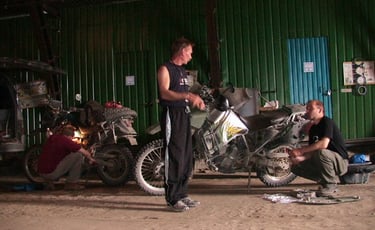


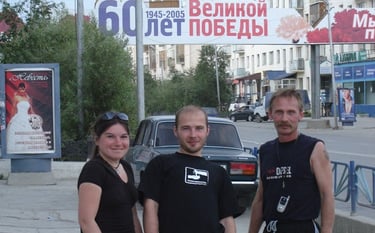
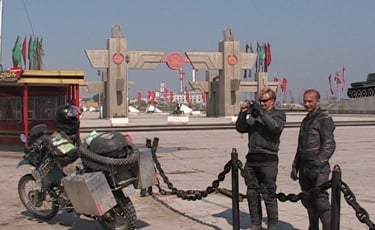

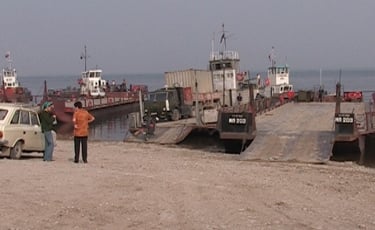

Day 36 (11) – July 12, Ulu to Bol.Hatymi on M56 – 433 km
South on M56. Beautiful weather. Today we had mostly good gravel and even some sections of tarmac. In Tommot we had a decent meal and gassed up. We went through small mountains, saw small patches of snow, admired river view and stopped for the night at a place strangely looking like an organized camping. The surroundings were breathtaking and the green was the deepest I’ve ever seen.
Day 37 (12) – July 13, Bol.Hatymi to Vyeselaya on M56, Amurskaya Oblast – 372 km
It rained heavily at night but the tents held up bravely. Today we had more hills and due to rain the road was very slippery.
By Neryungi we gassed up and took some pictures with soviet style concrete art. Today Natasha was refused the right to relieve herself. The gas attendant told her to simply go home. As we went further south it seemed that people were becoming more indifferent not only to us but to each other.
By the time we entered Amurskaya Oblast, it was sunny and hot again. In Tynda, when I was looking for a hairdresser, Jacek was approached by a motorcyclist who wanted to talk to us and hung around until we left. Virtually from nowhere a TV crew showed up. Jacek was being interviewed by a blond reporter when I came back and joined in. I guess two long distance adventurers on motorcycles were not a common site in Tynda. At the hairdresser Natasha got a thorough hair wash and Jacek decided on a military style hair cut. Later we went to some restaurant, had a super meal and chatted with our new friend. Sergey lead us to outside of the city on his Honda, took some pictures and said good bye.
We continued through some hills when the KLR started to dance a bit. It’s been over 10 years since I caught a flat tire so I forgot how it feels. Nevertheless, we stopped to find a 2 inch nail stuck in my Pirelli. It was actually getting dark but I had no choice, the tire deflated and there was no way to move the bike anywhere. With flash lights in our hands we managed to change the tube and inflate the tire with my Walmart compressor. Oh, no! During a key operation the compressor gave up. Luckily the tire was hard enough to move the bike. In the meantime Jacek found a suitable accommodation space in the woods right by a creek.





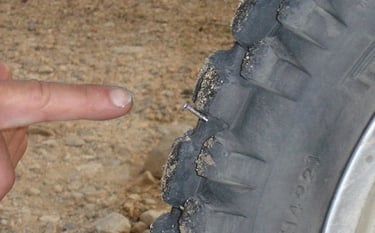
Day 38 (13) – July 14, Veselaya to “Proyekt Amur” by Uteni, Chitinskaya Oblast - 297 km
In the morning I fixed my compressor and Jacek played a tough guy by taking a dip in freezing water. We continued on a gravel road to Never where we met up with the new Trans Siberian road in the process of construction. This stretch had no bridges so we headed for Skovorodino.
On a gas station we had to tighten our loose steering columns. After so many kilometers of shaking roads they needed a small service. When we ate in a nearby café it started to pour heavily. In full rain gear we rode on some local gravel road hugging the railway until we saw some vehicles entering the newly built highway. Here it was, “Project Amur”, a completed section of wide road. It wasn’t paved yet but the gravel was well packed and some vehicles cruised at 100km/h.
For the night we stopped at an abandoned construction crew site and stone quarry area at the Chitinskaya Oblast border.
Day 39 (14) – July 15, Uteni to “Proyekt Amur” by Shaldura – 338 km
It rained on and off through the night and in the morning. We waited for a window with no rain and by noon we left the site. Soon it cleared and we had lots of sun again. Since there was no gas station for the last 350kms and there wasn’t supposed to be any for the next 350kms again we had to gas up. At the “zapravka” Jacek was approached by an angry block, who complained that Jacek rode through a pothole and spurted some water on him. The guy was quite aggravated and wanted to fight Jacek. Lots of people around and Jacek’s apologies defused the situation and everybody moved on.
Some distance further break time was due so I stopped on the top of the hill. Jacek approached slowly and shut of the engine. Strangely, the ignition was off but the starter kept on turning the engine. In complete distress we panicked. If we don’t fix it immediately the starter could burn. A quick decision was made to disconnect the battery. Indeed the starter stopped. We played for a while with the stuck starter relay, tapped it and shook it. At last it seemed to work just fine.
Soon the gravel road ended and we had to take an extended detour through some forgotten villages. Lack of proper signs and nonexistence of a new road on my GPS made us wonder in circles. A local farmer showed us the right route which was just an earth road with big holes; Kolyma déjà vu. Amazingly we saw a transport truck coming through it.
Back on “Project Amur” it was a serious construction site for over 100kms with climbing detours and very rough surface. Now we were able to pass chains of previously speeding vehicles, mostly Japanese right wheel driven machines. There is a booming car business in eastern Russian. Used Japanese models are brought to Vladivostok and from there transported by any means to central Siberia, hence the one way traffic. Lots of them make it on the new road but I am not sure in what kind of condition they arrive to their buyer.
A mile away from the road, one of the abandoned road workers’ campsite seemed to be a suitable place to make a camp. I looked at the rear of my bike and I saw no license plate, it was gone. The whole lower plastic fender part holding the license plate was torn off..
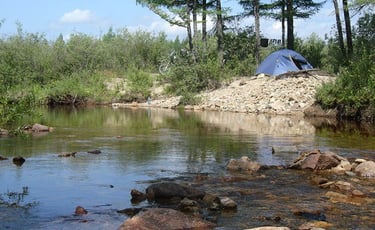

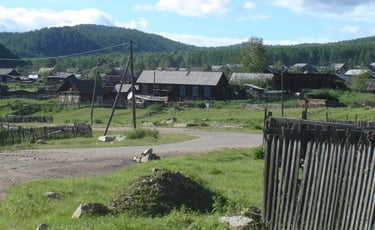

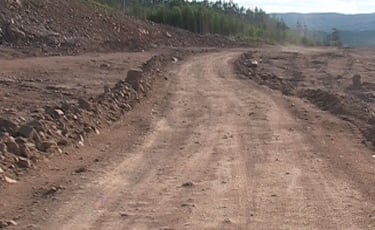

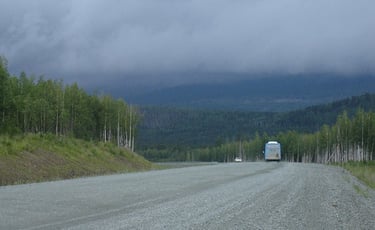

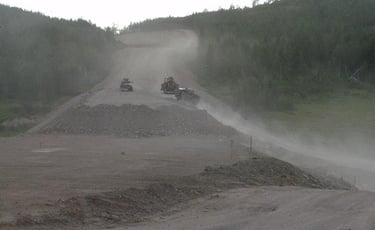

Day 40 (15) – July 16, Shaldura to Chita – 440 km
Soon “Poject Amur” ended and we followed a local road to Chernyshevsk. In this secluded part of Siberia where civilization slowly crawls in, everything seems to revolve around the Trans Siberian Railway. The new road actually slaloms around the railway at all times.
In Chernyshevsk, while eating at a café, we socialized with local truckers who were already drunk. It wasn’t much fun but we were patient and polite. The truckers suggested we should take a shorter new road which later would turn into tarmac.It rained again and the road turned into an ice ring. Though it was gravel we made very slow progress on now thin slushy mud and mostly corrugated surface.
At about 140kms to Chita we concluded our far eastern, 4000kms, off road adventure. It was an indescribable pleasure to be back on tarmac and knowing it was going to be there for some time.
In Chita we stopped by a hotel Volna (“wave”) and were immediately surrounded by a group of nicely dressed young people. Inside the hotel’s banquet hall a wedding was celebrated and we were invited. Unfortunately first we had to find a guarded parking for our bikes. We made several circles around the city and not until the militia in their Uaz got interested and took us to a suitable place we were able to leave the machines secured for the night. Very friendly young militia men drove us back to the hotel. By then the wedding was over. Weddings in Russia usually end by midnight.
Taking a freezing cold shower was for sure an energizing experience though at moments I wasn’t sure if parts of my body still existed. In Russia the central heating stations are shut off for maintenance during summer. For Natasha’s comfort a very nice floor girl gave us an electric teakettle to warm up enough water.
We spent the night in warm rooms with a tacky seventies décor.
Day 41 (16) – July 17, Chita to hilly steppe by Hoshun-Uzur – 583 km
My second mattress was not possible to patch so we visited a local market. Among varieties of products I found a decent mattress. A Chinese seller didn’t want to bargain.
Out of curiosity I checked my GPS and I was shocked to find out that all of the maps of Mongolia didn’t load. It was a major setback to us. We couldn’t go to Mongolia without a general map. We left the bikes with Natasha near the center square and went with my Mapsource disc to a nearby internet café. Without much luck we came back to our bikes to find two Australian bikers, Scott and Lora, on their 250cc Yamies doing the RTW. This was their last section Vladivostok-London. Good luck guys, I hope you made it all right back to Australia.
Before we left Chita we went to local flee market where I found a starter switch form Kamaz. It was just in case Jacek’s relay gives up again. On one of the gas stations I asked some construction men to help me fudge a new license plate. They found a piece of metal plate, blue oil paint and I was hard at work making my own plate.
Scott and Lora caught up with us a few times. On one occasion we stopped to say hi to yet other two bikers. They were from Great Britain and were heading to Vladivostok. One gentleman was on Honda Pan European and very close to the “Project Amur”. I am curious how he made it.
The taiga ended and we entered an open hilly area. We were in Respublika Buryatiya. We passed some pretty sleepy villages. The steppe seemed to be smooth so we climbed one of the hills and stopped there for the night. Strong winds from the south moved heavy rain clouds. We were already in our tents.
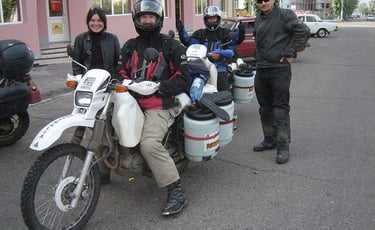

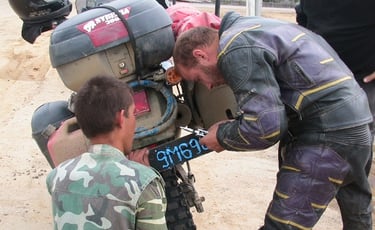




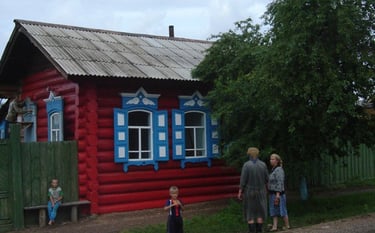
Day 42 (17) – July 18, Steppe to woods by Turuntayevo – 168 km
Ulan-Ude felt like Cairo. We negotiated unknown streets until we found the main square with the largest head of Lenin I’ve ever seen. Together with Natasha we went to an internet café where very friendly and curious guys were eagerly helping to install mapsource, but without success. We left disappointed. Next on the agenda was an oil change. We stopped at a place looking like a car parts store where a friendly tall Buriyat was very happy to help. He used to have a Japanese bike and felt like a biker. Dima drove me to a market where I got enough good oil for two bikes. When we were changing oil Natasha was let to work with their store computer to hopefully load my GPS. Again, no success. In the mean time Dima already contacted a local GPS salesman who agreed to meet us at his office. Stas was unbelievably patient and let Natasha play with his computer for couple of hours. I couldn’t believe, we wasted that much time for nothing. Natasha was unable to load any maps. Stas suggested that we should go to see Lake Baikal and return in two days. He might find a solution then. All this time Dima waited for us outside in the car.
Later, our new friend took us for supper. We stopped on outskirts at a traditional Buriyat eatery. Looking at a newly built Buddhist temple we ate carrot salad and pozy. Huge thanks to Dima for his unbelievable help and hospitality.
We spent the night camping in the woods.
Day 43 (18) – July 19, Turuntayevo to Ust Burguzin and back to Turka – 344 km
Sheer arriving at Lake Baikal was an excitement of its own. I expected it to be a remote area and in a way it was. However, the presence of tourists was evident. Along the road there were signs leading to different resorts and vacation spots popular among residents of Ulan-Ude.
We followed the shore to Ust-Burguzin riding partly on and off the pavement and through some road construction. We stopped by the river ferry terminal where there were other vessels docked. One of our plans was to take a boat across the lake but we scrapped it after we found out the price for this service. Since the weather was so gorgeous we even abandoned our second plan; visiting the Zabaikalskiy National Park. We talked to the babushkas selling local dried fish who insisted we don’t take pictures of them. We bought some local beer (awful), dried fish, pirozhki and headed for the local beach.
We couldn’t miss the opportunity of swimming in the deepest lake in the world. Water was great; the beach was clean and sandy. We ate dried Omul, admired the views and totally relaxed. Later when more drunk locals began to flock the beach, we had to leave as they wanted to ride our bikes. One completely wasted hunk showed off his Ural riding abilities by making circles and lifting his sidecar.
We rode back south and found a beautifully situated site (spontaneous infrastructure) right on the lake. I think every traveler dreams of sunset on Lake Baikal. Well, today we witnessed it.
Day 44 (19) – July 20, Turka to Kyahta – 410 km
Back in Ulan-Ude Stas brought his Mapsource discs. Natasha worked tirelessly for a couple of hours with his computer but again wasn’t able to load any maps. Stas’s clients and friends started showing up at his office. One of them, a very devoted hunter and GPS lover brought his own small Sony laptop (apparently used in Japanese tanks). He showed us his detailed GPS maps and started to compare them with Mapsource products irreversibly embarrassing their quality. Stas’s computer didn’t want to cooperate so we suggested to try the small Sony laptop. We connected our GPS to a com port and… success! We loaded all necessary maps for Mongolia. We said thanks to Stas and his friends, they wished us luck and we left. Outside it just rained. While watching the bikes Jacek made a new friend who let him sit out the rain storm in his van.
Our last moments in Ulan-Ude were quite shocking. Many streets were practically flooded and we had to ride through some 100 meters long and foot deep pools. I guess no one ever cleaned the sewers there.
By the time we arrived to Kyahta the border was closed, yet there were already cars lined up in front if the gate. There wasn’t much sense joining the cue so we rode a few kilometers to the nearby woods for the night.

